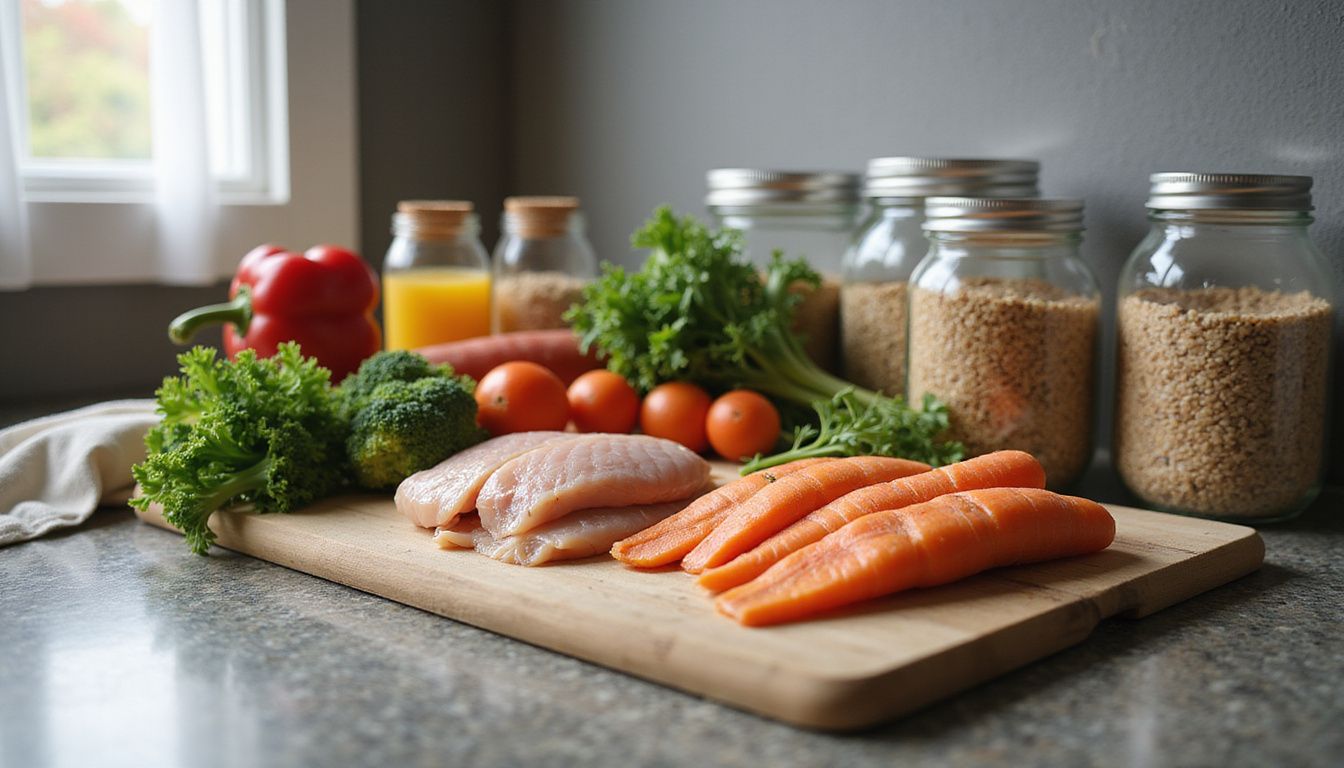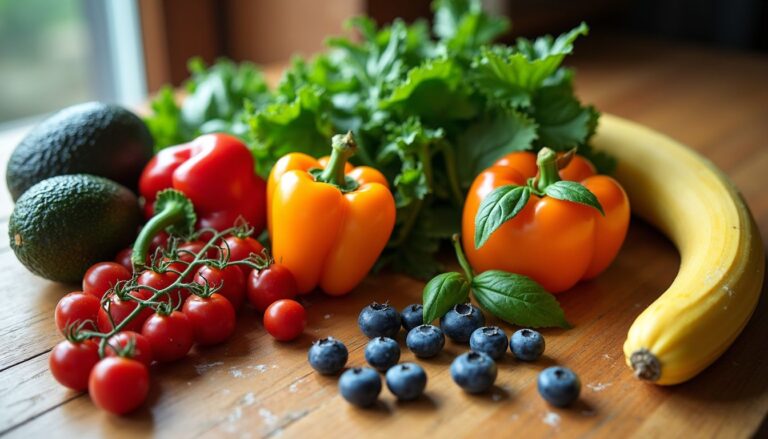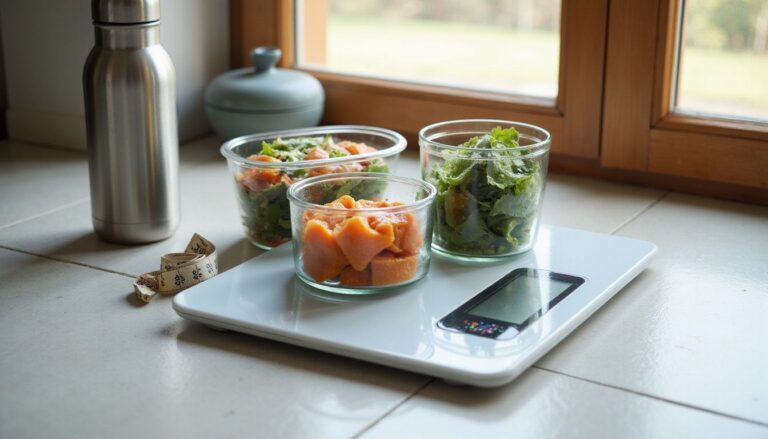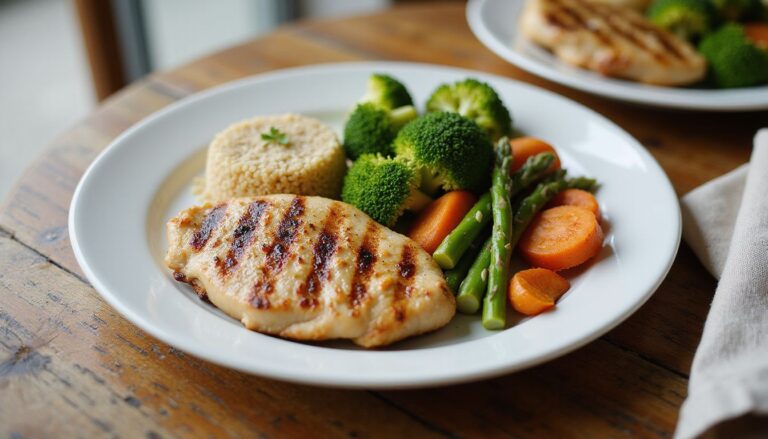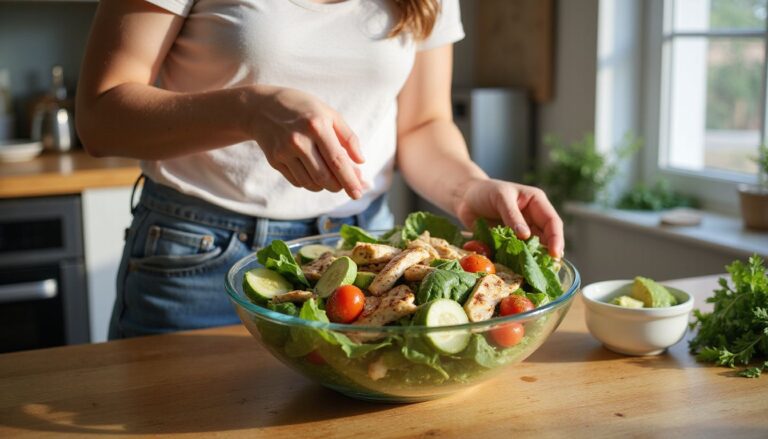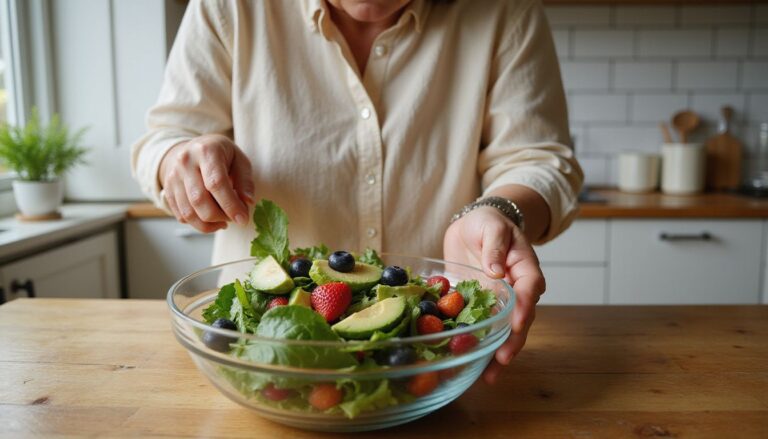7-Day Gym Diet Plan For Muscle Gain: Best Meal Plan And Workout Routine
Our Nutrition Assistant AI Suite will transform your body. You will lose fat, get toned, and build muscle. Gain confidence and optimal health.
You train hard but still struggle to add size. A simple meal plan for muscle gain can change that. Research-backed nutrition paired with smart workouts helps you gain muscle faster and stay healthy.
This guide walks you through a clear 7-day eating plan, food lists, practical tips, and a weekly workout split. You will see how protein, carbohydrates, and healthy fats power your progress. Use these steps to support muscle growth and get more from every session.
Keep reading if you want real results from your time at the gym.
Key Takeaways
- Aim for about 1.0 to 1.5 grams of protein per pound of body weight daily, about 2 grams of carbohydrate per pound, and let fats provide 15 to 20 percent of calories.
- The International Society of Sports Nutrition notes that higher-protein diets support muscle mass and recovery during both building phases and calorie deficit periods.
- Choose lean meats such as chicken and fish, whole grains, beans, dairy like Greek yogurt, nuts, seeds, avocados, leafy greens, and starchy vegetables.
- Limiting processed foods high in added sugar and saturated fat reduces inflammation and stabilizes energy for better performance and recovery.
- Supplements can fill gaps: whey protein around 25 grams post-workout, creatine monohydrate at the recommended dose, BCAAs if your protein is low, and a basic multivitamin.
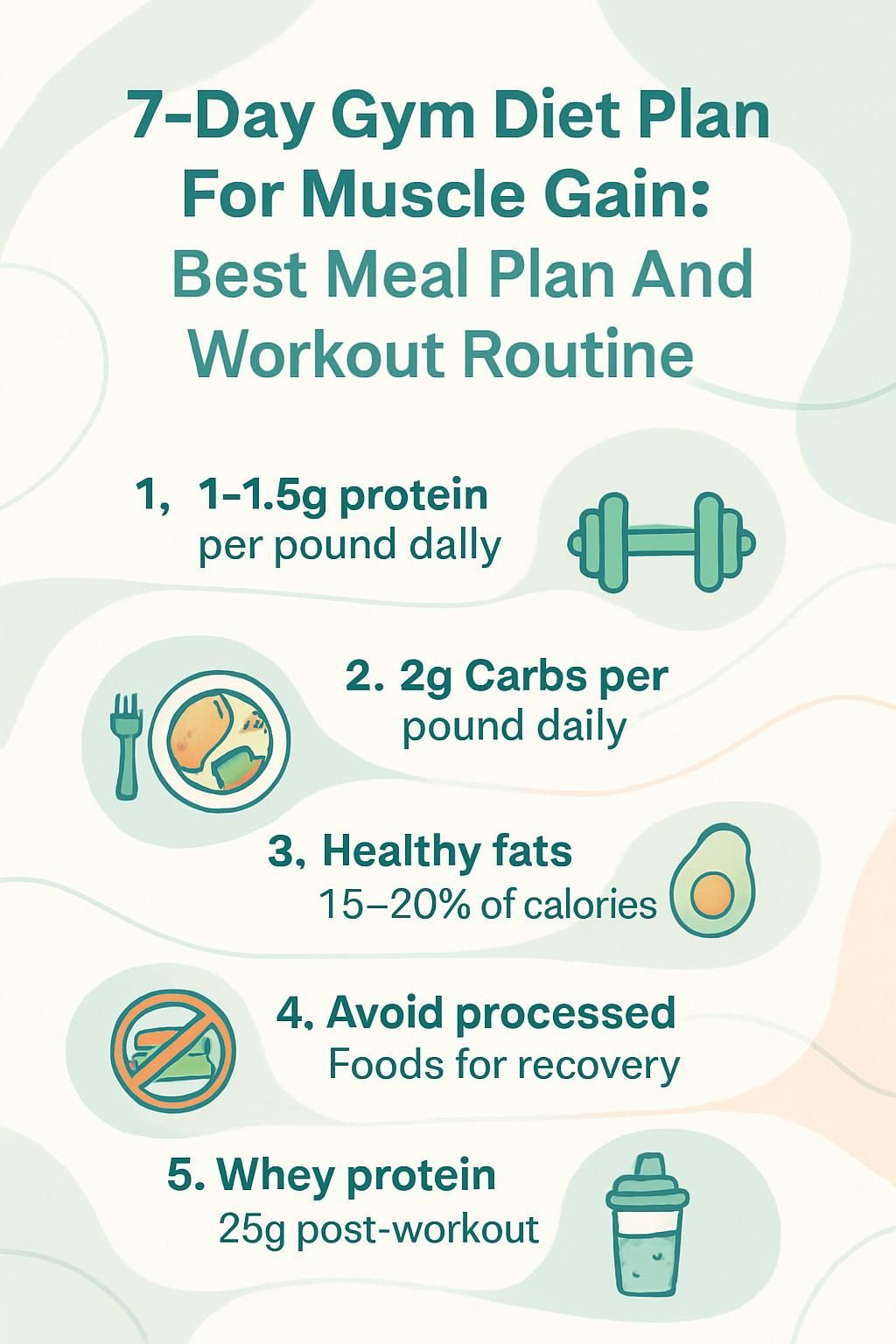
Why is a Gym Diet Plan Crucial for Building Muscle?

A structured gym diet plan gives your body the raw materials to repair and grow muscle. Protein supplies amino acids, carbohydrates restore glycogen, and healthy fats support hormones that influence strength.
Consistent eating makes it easier to hit your daily calorie target. That is crucial if you want to build muscle or increase body weight. After I swapped high-sugar snacks for lean meats and sweet potatoes, my recovery and day-to-day energy improved.
Sticking to a bodybuilding meal plan also keeps your training on track. You get steady fuel for hard sets and faster recovery between sessions.
Key Nutrients to Support Muscle Growth
Eating for muscle means meeting clear nutritional needs. Focus on protein for repair, carbohydrates for energy, fats for hormones, and water for recovery.
How Does Protein Help Muscle Repair and Growth?
Strength training creates tiny tears in muscle fibers. Protein provides amino acids that fix those fibers so they grow back stronger. Good sources include chicken, eggs, fish, beef, dairy, and beans.
For active lifters, a common target is 1.0 to 1.5 grams of protein per pound of body weight per day. If you weigh 180 pounds, that is roughly 180 grams daily. Both animal protein and plant protein can work. A fast-digesting whey shake after training can jump-start muscle protein synthesis.
Sports nutrition groups report that higher-protein diets support strength gains during building phases and help maintain lean mass during a calorie deficit.
Why Are Carbohydrates Important for Workout Energy?
Carbohydrates are your main training fuel. They refill glycogen in your muscles so you can push hard and recover well. Many athletes get 55 to 60 percent of daily calories from carbs.
For muscle gain, a simple target is about 2 grams of carbohydrate per pound of body weight per day. Choose whole grains, starchy vegetables, fruit, and plenty of greens to keep energy steady.
Eat up to 50 grams of carbs at least one hour before training. After your workout, pair carbs with protein at roughly a 2 to 1 ratio. For example, 50 grams of carbs with 25 grams of protein supports recovery.
Carbohydrate Summary
| Nutrient | Recommendation |
|---|---|
| Carb Percent of Calories | 55 to 60 percent |
| Daily Carbs per Pound | About 2 g per lb, 180 lb equals ~360 g |
| Pre-Workout Intake | Up to 50 g, about 60 minutes before |
| Post-Workout Ratio | Carbs to Protein about 2 to 1 |
Used correctly, carbs help you lift more, recover faster, and keep focus during longer sessions.
What Role Do Healthy Fats Play in Muscle Building?
Healthy fats support hormone production and muscle hypertrophy, which means muscle growth. A common guide is about 0.4 grams of fat per pound of body weight daily. For a 180 pound lifter, that is near 70 grams per day.
Sources include avocados, nuts, seeds, nut butters, olive oil, and other plant oils. Fat contains 9 calories per gram, which helps you reach a higher daily calorie target if you struggle to gain weight.
“Fats are not your enemy; the right fats help you lift heavier and recover faster.”
On days I added avocado or nut butter, training felt stronger. Keep fat around 15 to 20 percent of total calories, and limit saturated fat for better health and weight management.
How Does Hydration Affect Muscle Recovery?
Water supports digestion, nutrient absorption, and temperature control during exercise. It also helps transport amino acids and glucose to your muscles after training.
Even mild dehydration can hurt performance and slow recovery. Water should be your main drink. Smoothies or protein shakes add fluid plus nutrients. Sports drinks can help on very hard days, but most workouts only need water.
Best Foods to Promote Muscle Gain
Whole foods supply steady energy and the nutrients your body needs to recover from lifting. Build meals around these choices.
What Are the Top Protein Sources Like Chicken, Turkey, and Fish?
Chicken breast has about 25 grams of protein in 4 ounces and is low in fat. Turkey offers similar benefits. Fish such as salmon, tilapia, and cod are also great options. Salmon adds healthy fats along with protein.
Eggs and egg whites are quick to prepare and easy to portion. One large egg has about 6 grams of protein. During a natural bodybuilding prep, I often used chicken for lunch and salmon for dinner to hit my protein target and keep my body composition in check.
As a rule of thumb, include a palm-sized portion of protein, about 4 ounces, at each main meal.
Which Dairy Products Support Muscle Growth?
Low-fat milk provides about 8 grams of protein per cup and helps with recovery. Greek yogurt is higher in protein, often around 15 grams per single-serving cup, making it a solid breakfast or snack.
Cottage cheese contains casein protein, which digests slowly and supports recovery overnight. Try cottage cheese with tomatoes or green beans for a simple meal. Cheese can fit your plan in small amounts, adding protein and calcium.
After tough sessions, I often mix plain Greek yogurt with oats for a quick recovery meal that supports muscle repair.
What Are Good Carbohydrate Options for Muscle Gain?
Choose slow-digesting carbs to fuel training and recovery. Whole grains like brown rice, quinoa, and oats provide steady energy. One cup of cooked rice or oats gives about 50 grams of carbs.
Starchy vegetables include potatoes, sweet potatoes, corn, and peas. Fruit such as bananas, apples, oranges, grapes, and berries fits well too. A serving of fruit averages about 25 grams of carbs, except melons, which are lower.
Popcorn makes a light snack with fiber and carbs. Oats at breakfast and sweet potatoes at dinner kept my energy consistent during heavy training weeks.
Why Include Vegetables and Greens in Your Diet?
Vegetables and leafy greens round out your 7 day meal plan with fiber, vitamins, and minerals. Leafy greens like spinach and kale are rich in nitrates that may support strength.
Non-starchy vegetables such as broccoli, tomatoes, zucchini, peppers, cucumbers, mushrooms, onions, and green beans aid digestion and help you absorb nutrients. Since these foods are low in calories and carbohydrates, you get more room for protein and carb staples while still meeting micronutrient needs.
A colorful plate supports recovery and overall health while you build muscle.
What Healthy Fats Should You Eat for Muscle Health?
Focus on unsaturated fats that support heart health and hormone balance. Add almonds, walnuts, chia, sunflower, and flax seeds. Include avocados and nut butters for extra calories when needed.
Use olive oil or avocado oil for cooking or dressings. Healthy fats raise calorie density to help lifters who struggle to gain weight. I often add a tablespoon of olive oil or a handful of nuts to bump total calories without relying on fried foods.
How Can Plant Proteins Like Legumes and Beans Help?
Beans and lentils, including chickpeas, black beans, kidney beans, and pinto beans, provide quality plant protein and fiber. One cup of cooked beans or lentils gives about 15 grams of protein.
Studies suggest plant proteins such as soy, pea, and rice can support muscle repair when total protein is adequate. These foods also improve fullness, which can help manage body weight while preserving muscle.
Swapping in lentil salads or chickpea stews kept my costs lower and my stomach comfortable while still supporting strength gains. Pea or rice protein powders also work well in shakes.
What Foods Should You Limit or Avoid for Muscle Gain?
Some foods add calories without helping your goals. Limiting them can improve your results and your energy in the gym.
Why Avoid High-Sugar Snacks and Processed Foods?
Cookies, candy, pastries, and ice cream pack a lot of sugar and unhealthy fats. These choices can lead to blood sugar spikes and dips, which drain energy during workouts.
Processed snacks often add calories without protein, vitamins, or minerals. They may also increase inflammation, which can slow recovery. Once I traded packaged snacks for whole foods like eggs, steak, or nuts, my strength and focus improved.
Pick nutrient-dense foods so your 7-day meal plan supports muscle repair, body composition, and mental health.
How Does Alcohol Affect Muscle Growth?
Alcohol can slow muscle protein synthesis, the process your body uses to build muscle after training. It can also reduce performance, disrupt hormones like testosterone, and lengthen recovery time.
Regular drinking is linked to higher body fat, which makes it harder to reach fitness targets. Limiting alcohol helps you get more from your training and your dietary supplement routine.
What Are the Downsides of Deep-Fried and High-Fat Foods?
Deep-fried items like fries, onion rings, fried chicken, and fried fish add many calories with few nutrients. These foods can raise inflammation and increase long-term disease risk.
Eating very high-fat meals right before training may cause stomach discomfort and reduce performance. I noticed that after fried meals such as burgers or fried pork, my energy dropped and sessions felt sluggish.
Why Limit Foods High in Saturated Fats?
Fatty cuts of meat, processed meats, full-fat dairy, and many baked goods are high in saturated fat. Diets high in saturated fat raise heart disease risk. They may also impair recovery after hard training.
Balance your protein and fat intake. Swap some saturated fats for nuts, seeds, and plant oils. When I replaced heavy cheese snacks with nut butter or avocado toast, soreness eased and workout energy improved.
Recommended Supplements to Boost Muscle Gain
Food comes first. Still, a few supplements can cover gaps and support training when your diet is already solid.
How Does Whey Protein Support Daily Muscle Needs?
Whey protein digests quickly and supports muscle protein synthesis after workouts. About 25 grams post-workout is a common target. Mixing whey into shakes or oatmeal is an easy way to reach your daily protein goal.
Pair whey with carbs after training for better recovery. If your meals fall short on protein, whey can help you close the gap.
What Benefits Does Creatine Provide for Energy?
Creatine monohydrate increases your muscles’ stores of ATP, which is quick energy for intense efforts. Research shows creatine can raise strength and power during resistance training.
Expect the biggest payoff on heavy lifts and sprints. Creatine is safe for healthy adults when used as directed. Many lifters use it to support muscle gain and training volume.
How Do BCAAs Aid Muscle Recovery?
BCAAs, or branched-chain amino acids, may reduce muscle breakdown during tough workouts and may lessen soreness. They are most helpful if your overall protein intake is low.
You also get BCAAs from complete proteins like meat, dairy, soy, and whey. When my shake included whey with added BCAAs, my legs bounced back faster after hard sessions.
Why Take Essential Multivitamins for Muscle Health?
A multivitamin can help cover micronutrient gaps, especially during intense training or when calories are low. Nutrients like vitamins A, C, D, E, plus zinc, magnesium, and B vitamins support immunity and energy metabolism.
If your diet lacks variety, a basic multivitamin may help. Still, it should not replace vegetables, fruits, whole grains, dairy, fish, eggs, or chicken. Talk with a registered dietitian or health care provider before starting any supplement.
7-Day Gym Diet Plan for Effective Muscle Growth
Use this 7-day plan to support workouts, recovery, and steady muscle gain. Adjust portions to match your calorie needs.
What Does Day 1’s Meal Plan Look Like?
Breakfast: oatmeal with berries and scrambled eggs for balanced carbs and protein. Morning snack: Greek yogurt with nut butter for healthy fats and protein.
Lunch: grilled chicken breast, brown rice, and mixed greens with a tablespoon of olive oil. Afternoon snack: sliced vegetables with hummus for fiber and plant protein.
Dinner: baked salmon, sweet potato, and steamed broccoli. Post-workout: a protein shake. Day 1 totals about 1,498 calories, 103 g protein, 131 g carbs, 28 g fiber, 60 g fat, and 1,585 mg sodium. These meals are easy to prep and support recovery on busy days.
What Are the Meals for Day 2?
Day 2 targets around 1,495 calories, 93 g protein, 118 g carbs, 25 g fiber, and 73 g fat. You will get protein from both animal and plant sources, plus plenty of vegetables.
Snacks include mixed nuts and fruit for steady energy. Sodium stays near 1,522 mg to support hydration. This mix of healthy fats and whole grains fuels workouts without weighing you down.
- Breakfast: scrambled eggs with spinach on whole grain toast
- Lunch: grilled chicken breast, quinoa, steamed broccoli, side salad with olive oil
- Snack: apple with almond butter
- Dinner: baked salmon, sweet potato, sautéed mixed vegetables
- Evening Snack: Greek yogurt with berries
This balance supports muscle repair and strength gains while avoiding high-sugar, deep-fried choices.
What Should You Eat on Day 3?
Day 3 aims for about 1,510 calories with 126 g protein, 124 g carbs, and 57 g fat. Use grilled chicken or fish for protein. Choose brown rice or oats for long-lasting energy.
Add spinach and broccoli at lunch and dinner for fiber and key vitamins. Pick Greek yogurt or cottage cheese for snacks to stay full and support muscle repair. A small handful of almonds adds healthy fats that aid hormone production.
Hydrate well throughout the day. This pattern kept my hunger in check when training volume increased.
What Is the Meal Plan for Day 4?
Breakfast: scrambled eggs and spinach on whole grain toast. Mid-morning snack: Greek yogurt with sliced almonds for protein and healthy fats.
Lunch: grilled chicken breast, brown rice, steamed broccoli, and carrots. Afternoon snack: carrot sticks with hummus for complex carbs and plant protein.
Dinner: baked salmon, quinoa, and roasted asparagus for protein and omega-3 fats. Day 4 provides about 1,492 calories, 95 g protein, 148 g carbs, 26 g fiber, and 62 g fat. Timing these meals around training improved my recovery last season.
What Does Day 5 Include?
Day 5 totals roughly 1,496 calories with 111 g protein, 100 g carbs, and 75 g fat. Combine animal and plant proteins to support growth. Use prep-friendly ingredients like grilled chicken, chickpeas, leafy greens, and brown rice.
Snacks such as Greek yogurt or nuts help you stay full. Fiber reaches about 29 g, with sodium near 1,785 mg to balance hydration.
What Are the Suggested Meals for Day 6?
Breakfast: scrambled eggs with spinach and whole grain toast, plus a cup of low-fat milk if you need more protein. Lunch: grilled chicken breast, quinoa, and steamed broccoli.
Snack: Greek yogurt with walnuts or almonds for healthy fats and protein. Dinner: baked salmon, brown rice, and roasted vegetables such as carrots or zucchini. Add a piece of fruit in the evening to reach a 35 g fiber goal.
Day 6 totals about 1,497 calories, 89 g protein, 160 g carbs, 58 g fat, and 1,795 mg sodium. Meals like these kept me full and sped up recovery after hard lifts.
What Should You Eat on Day 7?
Day 7 offers a balanced finish. Breakfast: Peanut Butter-Chocolate Chip Oatmeal Cakes, about 376 calories and 12 g protein. Snack: a banana with a tablespoon of peanut butter, about 210 calories and 5 g protein.
Lunch: a Turkey BLT Wrap, about 362 calories and 17 g protein. Afternoon snack: a quarter cup of dry-roasted almonds, about 206 calories and 7 g protein.
Dinner: Lemon Chicken Orzo Soup with kale plus a slice of whole-wheat baguette, about 365 calories and 25 g protein. To reach about 2,000 calories, add a cup of strawberries to breakfast, double the peanut butter at snack, increase almonds to a half cup, and include a second baguette slice at dinner. Simple tweaks help match your training and muscle gain needs.
What to Eat Before and After Workouts?
Timing your meals supports performance and recovery. Focus on easy-to-digest foods before training and a fast recovery meal after.
What Are the Best Pre-Workout Foods?
About one hour before exercise, aim for 25 grams of protein and up to 50 grams of carbs. Oatmeal with berries and nuts, or a banana with almond butter, works well. These choices give steady energy and reduce stomach upset.
Avoid very high-fat foods, carbonated drinks, and very high-fiber items like beans or cauliflower right before training. A quick protein shake can also fit your pre-workout plan.
What Should You Eat Post-Workout to Recover?
Right after your workout, use a 2 to 1 carb to protein ratio, such as 50 grams of carbs with 25 grams of protein. A whey shake with fruit is ideal. Chicken with rice also fits the target.
Eat within 30 minutes if you can. Carbs plus protein help reduce muscle breakdown, restore glycogen, and kick-start muscle building.
Weekly Gym Workout Plan for Building Muscle
This weekly split trains each muscle group while giving enough recovery time. Progress by adding reps or weight each week.
What Exercises Target Chest and Triceps on Day 1?
Begin with a 5 minute dynamic warm-up. Start with the bench press for 3 to 4 sets of 8 to 12 reps. Gradually increase load or reps over time.
Follow with push-ups and triceps dips. Add one triceps isolation exercise like pushdowns or overhead extensions for 3 to 4 sets of 8 to 12 reps.
How to Work Back and Biceps on Day 2?
Open with compound moves: pull-ups and barbell rows, 3 to 4 sets of 8 to 12 reps. These hit your lats, mid-back, and biceps.
Then use isolation work such as dumbbell curls or hammer curls with the same set and rep range. Control each rep. Finish with a light stretch to aid recovery.
Why Is Rest Important on Day 3?
Muscles grow during recovery, not during the lift itself. A rest day lowers injury risk and prevents overtraining.
Light walking or stretching can improve blood flow without adding stress. Planned rest supports long-term consistency and progress.
What Are Effective Shoulder and Abs Workouts for Day 4?
Start with the overhead press for 3 to 4 sets of 10 to 15 reps. Next, use lateral raises to target side delts.
Strengthen the rotator cuff with light external rotations. Train your core with planks, hanging leg raises, and cable crunches. Emphasize form and a full range of motion.
What Should You Do on Leg Day (Day 5)?
Work the whole lower body. Perform squats, lunges, deadlifts, and leg presses, 3 to 4 sets of 8 to 15 reps.
Include single-leg work such as split squats to fix imbalances. End with calf raises and stretching to aid recovery and mobility. This plan helped me build strength and size while staying injury-free.
How to Combine Cardio and Core Training on Day 6?
Do 20 to 30 minutes of moderate cardio on a treadmill, bike, or rower. Change speeds every few minutes to stay engaged. Cardio at this level supports heart health and fat loss.
Then move to core training. Use planks, Russian twists, and bicycle crunches for 30 to 45 seconds each. Keep rests short to challenge endurance. Stretch at the end to cool down.
What Are Rest or Active Recovery Options on Day 7?
Use Day 7 to reset. Gentle yoga, walking, light cycling, or stretching helps your body recover and reduces burnout.
Meal prep for the next week, or review your plan for adjustments. Small steps on this day set you up for success in the next cycle.
How to Stay Consistent with Your Muscle Gain Plan?
Success comes from simple habits you can repeat. Plan your meals, track your intake, hydrate, and sleep well.
What Are Useful Meal Planning Tips?
Prep several proteins and carbs on the weekend. Make a pot of soup, cook a batch of rice, and portion chicken. Use the 3-3-3 method at meals, three protein, three carbohydrate, and three healthy fat servings.
Keep grab-and-go options ready, such as overnight oats, hardboiled eggs, Greek yogurt, nuts, fruit, and chopped vegetables. Variety helps you meet macronutrient targets without weighing every bite.
How to Track Calories and Macronutrients Effectively?
Use a tracking app. Log meals with a food scale for accuracy. Track protein, carbs, and fat daily.
Weigh yourself three times per week and aim for weight changes of 0.5 to 1 percent of body weight per week. Adjust calories monthly if progress stalls or moves too fast.
Why Is Daily Hydration Important?
Water supports digestion and helps your body absorb nutrients from protein, carbs, and healthy fats. It also improves endurance and body temperature control during hard workouts.
Keep a water bottle nearby so you sip all day. Protein shakes and smoothies count toward your fluid goal as well.
How Does Sleep Impact Muscle Recovery?
Quality sleep is the final piece of recovery. During deep sleep, your body releases growth hormone, which supports muscle repair and protein synthesis.
Adults who sleep less than seven hours often recover slower and feel more fatigued. On weeks I got a full eight hours after heavy sessions, soreness dropped and performance improved two days later.
Conclusion
Building muscle takes smart eating and steady training. A clear diet plan with enough protein, the right carbohydrates, and healthy fats will support muscle gain and better workouts. Use the 7-day plan to structure meals, then adjust portions to match your calorie needs.
Pair this nutrition plan with the weekly workout split and solid recovery habits. Track your intake, stay hydrated, and aim for consistent sleep. If you have health concerns or unique needs, consult a registered dietitian or health care provider. With consistent effort and evidence-based choices, you can build muscle while protecting your long-term health.
FAQs
1. What foods should I eat in a 7-day gym diet plan for muscle gain?
A balanced meal plan for muscle growth includes lean meats like chicken or turkey, fish such as salmon, eggs, dairy products like Greek yogurt or cottage cheese, whole grains including brown rice and oats, nuts and seeds, beans or lentils, leafy greens such as spinach or kale, and fruits like berries or bananas. These foods supply protein to repair muscles and carbohydrates to fuel workouts.
2. How many meals per day are best for building muscle with this routine?
Most evidence-based plans recommend eating four to six smaller meals each day instead of three large ones. This approach helps maintain steady energy levels; it also supports consistent protein intake throughout the day which is important for muscle recovery.
3. Should I change my workout routine during this 7-day meal plan?
Pairing your diet with a structured exercise schedule improves results. Focus on resistance training using compound movements such as squats, bench presses, deadlifts, rows, and pull-ups at least four days per week; add short cardio sessions if needed for heart health without sacrificing calorie surplus required for gaining mass.
4. Can you give an example of daily nutrition targets in this type of program?
For most adults aiming to build muscle while following a gym-focused regimen: target about 1 gram of protein per pound of body weight daily; consume complex carbohydrates making up roughly half your calories; include healthy fats from sources like olive oil or avocado accounting for about one-fourth of total calories. For instance: A person weighing 160 pounds would aim for around 160 grams of protein each day along with appropriate amounts of carbs and fats based on their caloric needs.
Summary: Eating nutrient-rich foods every few hours supports strength gains when paired with regular resistance training sessions focused on major movement patterns. Tracking macronutrient intake ensures you meet goals that promote effective progress toward increased muscular size according to current research findings.

